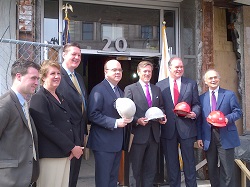
May 2014
|
The Mission of the Economic Development Administration (EDA) is to lead the federal economic development agenda by promoting innovation and competitiveness, preparing American regions for growth and success in the worldwide economy. The agency has a competitive grant process and has established the following investment priorities as criteria: collaborative regional innovation, public/private partnerships, national strategic priorities, global competitiveness, environmentally sustainable development, and economically distressed and underserved communities. Message From Acting Assistant Secretary
|
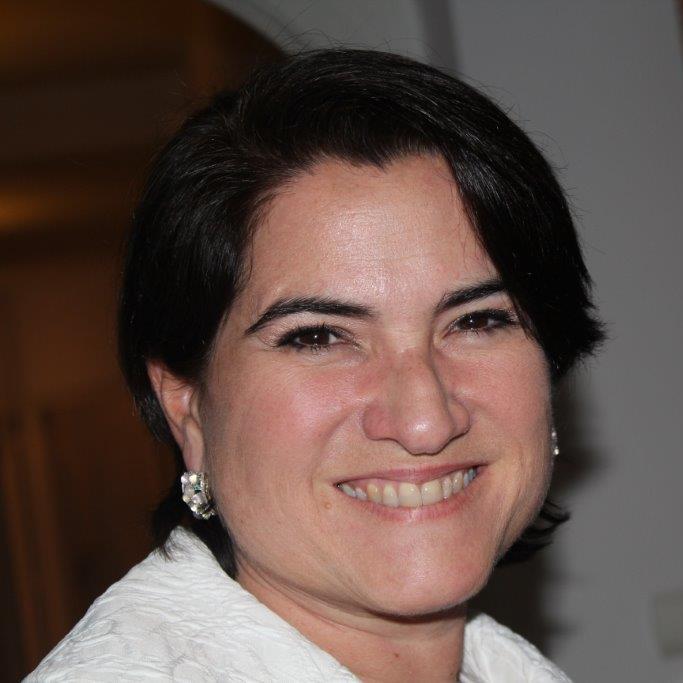 |
|
Photo of Elida Alcedo Guardia, General Coordinator of the Competitiveness and Trade Promotion Program in Panama |
Elida Alcedo Guardia works as General Coordinator of the Competitiveness and Trade Promotion Program for Panama. She coordinates activities derived from the IDB loan contract #1941/OC-PN. Its mandate is delegated by the Ministry of Commerce and Industry, which is the loan’s main Executor.
Before her experience in the public sector, Elida worked in the private sector with the Multinational Nestlé from 1987 until 2000; she left Nestlé to join the family business, dedicated to Agro-industry, Logistics and Real Estate where she worked from March 2000 until June 2010.
Elida majored in International Affairs at Florida State University (Panama Branch) and graduated from the MBA program at the Universidad Interamericana offered in tandem with a program from Georgetown University.
Q: You recently participated in the Americas Competitiveness Exchange. Can you talk a little bit about what you took away from the trip generally? Specifically, what influence did the recent ACE trip have on your thinking with regard to trade and investment with the U.S. or across the hemisphere?
A: To begin with, I must praise the initiative taken by EDA, the Department of Commerce, the State Department and OAS/RIAC, to invite players in the public, private and academic sectors from the hemisphere to the first Americas Competitiveness Exchange.
The experience was in general positive not only in its nature but essentially in its execution. The tour was very well organized, leading us through the spectrum of industries and research facilities established in the southeast of the United States, along with the possibility of interacting with participants from 20 countries, different backgrounds and age groups.
The setting was relevant in the sense that it showcased an area that suffered market shifts that were not only significant but also crucial for the subsistence of the region, depressed by the crisis lived not long ago. It impressed me to hear that the job losses amounted to more than 40 thousand. To small municipalities, this is huge.
Specifically, I could say that the Can Do attitude I found in all the cities was inspiring and led me to broaden my expectations for the future of my country. I also found similarities that lead me to think it could be replicated in Panama. The main problem was the loss of jobs; the solution has been to focus on innovation.
The close collaboration between academia and the public and private sectors is very impressive and sets an example for all our countries. The only factor that has the potential to discourage our efforts is the fact that the substantial investments made in Georgia, North and South Carolina might be more difficult to emulate in some of our countries due to budgetary constraints.
Trade and investment are the drivers of our economies. This type of experience not only reinforces the linkages between our countries, but the networking that it encompassed will certainly lead to new ways of expansion. Identifying new opportunities, no matter where in the globe is an important job for the Department of Commerce.
Panama has made a name for itself in the logistics arena becoming a Multimodal Hub for the Americas and with its geographical position is a natural ally for any trading partner. This must be taken advantage of by the whole hemisphere.
In conclusion, I have to mention that the exposure to highly specialized industrial settings linked to research facilities and academia, reinforces the notion that education is the base for all strategic initiatives. This was the most inspiring aspect of my experience during the Americas Competitiveness Exchange.
Q: Can you speak to Panama’s trade and investment relationship with the United States historically and currently?
A: Historically, Panama’s relationship with the United States has been focused on the Panama Canal. Panama’s economy is based largely on services industries that developed around its trans-isthmian canal, once operated by the United States, but returned to Panama in 1999.
Canal operations account for an important part of Panama’s GDP, with the largest traffic volume generated along the U.S. East Coast-to-Asia trade route (especially U.S.-China). The canal’s total economic impact, however, is far greater, supporting income and jobs in various services industries including warehousing, ship registry and repair, salvage operations, insurance, banking, and tourism.
Traditionally, the United States has been Panama’s main trade and investment partner. In 1991 Panama and the United States created a Bilateral Trade and Investment Council to strengthen trade ties between the two countries.
From 2001 to 2003, both countries engaged in exploratory talks aimed at considering the negotiation of a Free Trade Agreement. In November 2003 the start of negotiations was announced.
On June 28, 2007 The United States and Panama signed a Free Trade Agreement (FTA) after two and a half years and ten rounds of negotiations. Panama’s National Assembly ratified the FTA on December 13, 2007.
On October 12, 2011 the U.S. Congress approved the Trade Promotion Agreement with the Republic of Panama.
After completing a bilateral implementation process the Trade Promotion Agreement came into force on October 31, 2012.
Q: What do you see as the greatest opportunities for increasing trade and investment between Panama and the United States?
A: The Trade Promotion Agreement between Panama and the United States (TPA) will create new market access opportunities by eliminating tariffs and other non-tariff barriers to exports, promoting economic growth, and expanding trade between both countries.
The Agreement ensures that companies are protected against discriminatory or unlawful treatment, and provides a neutral and transparent mechanism for settlement of investment disputes.
Furthermore, the Agreement guarantees access to services markets in both economies, including in priority areas such as financial, telecommunications, maritime, computer, distribution, express delivery, energy, environmental, and professional services.
Panama’s strategic location as a major shipping route also enhances the importance of the Agreement. Approximately two-thirds of the Panama Canal’s annual transits are bound to or from U.S. ports.
The Agreement will remove barriers to agriculture and industrial goods entering both markets. It also provides significant infrastructure opportunities for Government procurement projects.
In addition to the ongoing $5.25 billion Panama Canal expansion project, the Government of Panama has identified almost $10 billion in other significant infrastructure projects.
Panama aims at having a stronger industry, standing mainly, up until now, on the services sector, which lacks accurate statistics. To reach this goal, we must take advantage of our geographical position and attract new businesses.
Panama is emerging as a hub with its multimodal infrastructure, which allows the connectivity needed to facilitate trade throughout the world.
I foresee viable joint ventures between hubs, in the USA and the rest of the Americas, whether based on air traffic, port infrastructure, railroads or any other type of infrastructure that facilitates trade and logistics.
The enlargement of the Panama Canal will be concluded during the year 2015, its impact will be felt on a global scale, and it has fostered investments in ports all around the globe.
The first phase of the Metro line opened on April 6th, the second phase is already up for a bidding process.
The Tocumen International Airport City, currently in design, will be a giant showroom, which will enable trade not only throughout the hemisphere but also across the oceans.
These, and some other infrastructure projects, are reinforced by a sound investment climate, setting Panama on a fast track, which will push forward this entire part of the world.
In this context, some laws tailored to protect and encourage foreign direct investments, are:
Free Trade Zones – Law 32, 2011
Hub of Multinational Companies Headquarters – Law 41, 2007
Panama Pacifico – Law 41, 2004
Ciudad del Saber (City of Knowledge) – Law 6, 1998
For more information please do not hesitate to contact us at the Program for Competitiveness and Trade and at the office of the Task Force for the implementation of the TPA, which is led by Mr. Norman Harris, former Panamanian Ambassador to the WTO. http://www.impulsopanama.gob.pa/ and www.micitpc.com.
SUCCESS STORY
Investing in Critical Public Infrastructure Results in Increased Exports and New Jobs
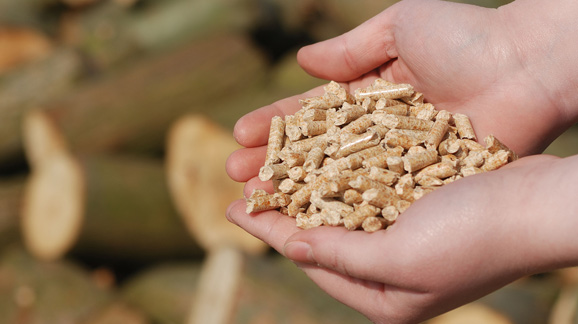
Wood Pellets produced at the Waycross-Ware County Industrial Park
Academia, government, and the private sector are constantly puzzling out ways to increase trade and exports. Export policy can be complicated, but increasing exports can be as simple as constructing a new rail spur.
In order to achieve the targets for cutting carbon emissions in Germany and in Europe as whole, the use of biomass for power generation is essential. However, the European wood market could not keep pace with the increasing demand for resources in this fast growing sector.
In 2010, local authorities in Waycross, Georgia, successfully concluded negotiations with a German energy firm, RWE Innogy, to build a new $135 million wood pellet manufacturing plant in the Waycross–Ware County Industrial Park. The pellets, which are produced from locally-sourced wood, are used as a cleaner-burning substitute for coal in the generation of electricity. But, the authorities in Waycross were faced with a challenge: how could these pellets be shipped quickly and cost effectively to major transportation hubs?
In 2010, EDA provided a $1.3 million grant to Ware County to help build a new rail spur, ensuring that the pellets could be shipped to the port of Savannah and from there to overseas buyers. In May 2011, the Georgia Biomass plant went online, and now the company has approximately 80 employees producing about 750,000 tons of wood pellets annually that are shipped to buyers in northern Europe. The wood pelleting plant operated by Georgia Biomass in Waycross is the largest of its kind in the world and has spurred the creation of new jobs at local timber firms due to the increased demand for their raw materials. This spill-over effect shows how important exports can be to the health of a regional economy, spurring increased sales and job creation in related sectors.
The Biomass plant exports more than just pellets – it also exports lower emissions. The pellets produced in Waycross are used primarily at the existing coal-fired power stations of RWE Supply and Trading GmbH, a leading European energy trading house. Replacing hard coal with biomass cut carbon emissions considerably.
While increasing exports is a big idea, it doesn’t mean that all the answers are big ones. Sometimes, something as simple as a rail spur can open up markets that are an ocean away.
SPOTLIGHT
First Americas Competitiveness Exchange Brings Together Business and Government Leaders from 19 Countries to Talk Innovation, Trade, and Investment
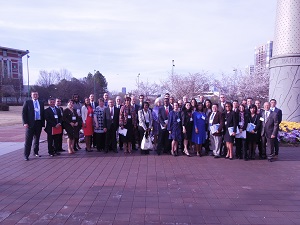 |
|
Participants from the Americas Competitiveness Exchange Trip in Atlanta, GA |
From March 31 through April 4, more than 50 participants representing government, business, and economic development organizations from 19 countries across the Western Hemisphere embarked on a tour of the American Southeast. The purpose of this trip was to provide a forum to share best practices, foster alliances, and create opportunities for two-way trade.
The packed agenda kicked off in Atlanta with visits to the Chamber of Commerce, the Global Center for Medical Innovation (GCMI), the Advanced Technology Development Center (ATDC), and VentureLab. These stops provided participants with a view into how Atlanta has become the number three city for Fortune 500 businesses and a booming medical technology cluster. Participants were treated to a tour of the ATDC facility and offered a glimpse of the innovative companies that are supported by the incubator.
The second stop on the tour was Greenville, South Carolina. Participants received a warm welcome and tour of the city from the Mayor of Greenville, Knox White. Everywhere the group stopped in and around Greenville, we heard the inspiring story of how a community that had been devastated by the decline of the textile industry had completely reinvented itself to become a major automotive hub. Tours of the EDA-funded Clemson University International Center for Automotive Research (CU-ICAR) and the BMW plant in Spartanburg illustrated what is possible when the private, public, and education sectors come together.
But it was several students from AJ Whittenberg Elementary School that provided the trip’s most inspiring presentation. Through corporate support and community involvement, Greenville opened a world-class school in one of the poorest parts of town. The curriculum emphasizes early education in math and physics in order to train the CU-ICAR and BMW engineers of tomorrow. Kids learn about physics by studying roller coasters and get to go to Disney World to apply what they’ve learned at the end of the lesson. The Greenville community understands the importance of nurturing kids – some as young as four – to ensure the continued success of the automotive and engineering cluster it has built.
In Conover, North Carolina, the delegation visited the Manufacturing Solutions Center to see how this EDA grantee is working to support entrepreneurs and help businesses test and develop innovative products such as Bootights and Jobst. The North Carolina Research Campus in Kannapolis, North Carolina conducts ground-breaking work in biotechnology, nutrition, and health. Both sites demonstrated that big things can happen in small towns with the right partnerships and dedication from the community.
The trip ended in Charlotte, North Carolina with visits to the EPIC Center at UNC Charlotte and Packard Place. Daniel Roselli the co-founder of Packard Place, a regional hub for innovation and entrepreneurship, succinctly summarized the point of all of the meetings, presentations, and conversations of the past 5 days: Success occurs when government, community, and entrepreneurs work together. Success depends on partnerships, and what is true of one region is true of an entire hemisphere. If the Americas work together, not only will our individual economies grow, but it will strengthen the entire hemisphere.
HIGHLIGHTS
Administration Launches Efforts to Support Global Entrepreneurship
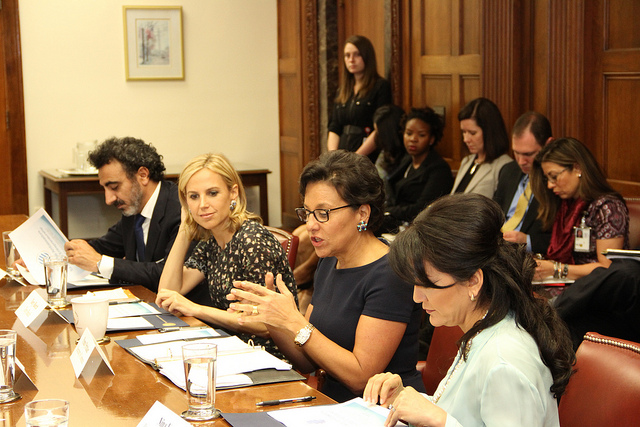
Secretary Pritzker Meets with PAGE Program participants
Entrepreneurs play a critical role in expanding the economy and creating jobs. EDA, the Department of Commerce, and the Obama Administration are committed to supporting entrepreneurs across the country and globally. In this vein, the White House recently announced a series of new steps to accelerate the success of entrepreneurs in the United States and worldwide.
The Presidential Ambassadors for Global Entrepreneurship (PAGE) program brings together a diverse group of successful American businesspeople who have committed to sharing their time, energy, ideas, and experience to help develop the next generation of entrepreneurs at home and abroad. The group is chaired by Secretary of Commerce Penny Pritzker, and the U.S. Department of State and the U.S. Agency for International Development (USAID) are also partners in this effort.
Other federal agencies are embarking on efforts to promote entrepreneurship as well. The Department of Homeland Security (DHS) will soon publish several proposed rules that will make the United States more attractive to talented foreign entrepreneurs and other high-skill immigrants who will contribute substantially to the U.S. economy, create jobs, and enhance American innovative competitiveness.
The National Institutes of Health (NIH) and the National Science Foundation (NSF) are launching a new collaboration to empower entrepreneurial scientists and address the critical gap between fundamental research and the development of a commercial entity. Academic researchers and entrepreneurs who receive Small Business Innovation Research (SBIR) funding from NIH will be eligible to pilot a new version of the NSF Innovation Corps (I-Corps) program that is specially tailored for biomedical technologies. NIH will also help scale up I-Corps by augmenting existing NIH-funded programs, such as the NIH Centers for Accelerated Innovation (NCAI), that focus on promising technologies developed by academic researchers. Faculty and students who participate in these new I-Corps programs will receive mentorship opportunities, entrepreneurial training, and modest funding to enable them to move their ideas from the lab to the market.
USAID recently launched U.S. Global Development Lab (The Lab), which will empower a global network of individuals to help create, solve and scale innovative solutions to global challenges by applying rigorous scientific, business, research, and technological expertise. In the next five years, scientists and technology experts at The Lab will create a new global marketplace of innovations and take them to scale to reach over 200 million people worldwide. The Lab is expanding a Global Development Alliance furthering LGBT equality through entrepreneurship and small and medium enterprise growth in Latin America. A new USAID Research and Innovation Fellowships Program will send more than 60 young U.S. leaders in science and technology to universities, NGOs, and companies in 12 developing countries this year.
This fall, the State Department will host TechCamps for women in El Salvador, Colombia, and Argentina to provide training to address key challenges in business formation, from financing to marketing. Additionally, the State Department will be launching two new exchange programs for entrepreneurs in the Western hemisphere.
|
|
|||
In This Issue
EDA Unveils New and Improved WebsiteHave you checked out EDA.gov lately? The updated interface makes it easy to find the information you’re looking for Make sure to visit our new, improved website for all the latest EDA news and grant announcements. American Job Training Investments: Skills and Jobs to Build a Stronger Middle ClassPresident Obama and Vice President Biden recently announced new federal investments using existing funds to support job-driven training. The White House issued a fact sheet the details the investments and efforts to support apprenticeships and other training opportunities to strengthen the middle class.
Provide Your Comments on the Proposed Selection Process, Criteria, and Submissions for the Second Round of the Promise Zone InitiativeYour comments are being solicited on the proposed selection process, criteria, and submissions for the second round of the Promise Zone initiative that has been announced via the Federal Register. Comments are due by June 16, 2014 and may be submitted at [email protected] with “Second Round Promise Zone selections” in the subject line. Questions or comments may also be directed by postal mail to the Office of the Deputy Assistant Secretary for Economic Development, U.S. Department of Housing and Urban Development, 451 Seventh Street SW., Room 7136, Washington, DC 20410 ATTN: 2nd Round Promise Zone selections |

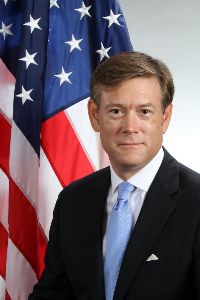 Dear Friends,
Dear Friends,